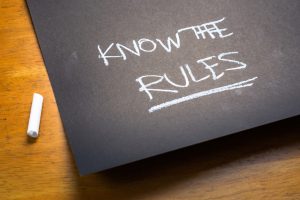By Andy Low

In our last article on gamification, we talked about producing a series of articles that discuss in details key game elements when designing a gamify solution. This article is version 2.0 in this series, and here we will discuss how Goals and Rules work in gamified solutions.
In the article on Simple reality, we explained why it is important to use simple reality and how to build it into a gamified solution. We have been emphasising that a gamified solution is not about merely slapping points onto a solution and called it gamification. In fact, in some instances, we have observed solutions that do not have clear goals. Without clear goals, which are fundamental in the design of a gamify solution how will players know what is the end game and how are players going to achieve them?
Let us jump right into it!
Goals & Rules
Goals and rules are like Parma ham and melon. Parma ham is savoury and dried while melon is sweet and moist. The combined effect of savoury and sweetness is magical, and that is what we should create with goals and rules in a gamify solution.
Each element plays a vital role in setting the end game and structure of a gamify solution; the goal provides the purpose, measurable outcomes and focal point of a solution while rules define the structure of the play and allow players to know how to play a game.
 Goal: Play vs Game
Goal: Play vs Game
I am sure many of us have this similar experience, you go for a regular jog with a friend, and suddenly he challenges you to see who will be able to reach the end of the park first.
In an instant, the jog turned into a game, and the goal of it is to reach the end point first. This is the main difference between a play and a game; a goal can motivate the player to display the desired behaviour to complete the objective. In the above example, it prompts both you and your friend to run as fast as possible reach the endpoint.
By the same token, goals, when applied correctly at the workplace, will motivate the desired behaviour to achieve a similar outcome. In many companies today, goals exist as year-end appraisal key performance indicators or KPI. We argue that the current format of measurement and goal setting lacks intensity, clarity and the right feedback mechanism to motivate desirable behaviour.
Do you think the current goals in your company motivate you and drive behaviour change including regular feedback?
How Do Goals Motivate Players?
A goal can provide the focal point, meaning and allow us to quantify the outcomes. With a goal, players will have the ability to measure the quality of their play; in the game of Monopoly, players can be assessed on the speed of their financial acquisition and the number of real estates they have acquired. A player that has gained more wealth has, clearly, been playing the game better than the other player who has acquired less wealth. This measurable outcome is an important feature that motivates players.
The second characteristic of a goal is to be specific and unequivocal; therefore, there is usually no doubt whether a goal has been achieved or not.
In the game Dunk Shot, how many shots a player made and whether a player has earned enough shots to clear a level is unequivocal.
Feedback On Goal Achievement
The feedback that a player receives from the gameplay is an essential feature in a gamified solution. As a player plays the game, they get notified of their progress and achievements along the way. This critical piece of information is vital and form part of what is known as a dopamine loop that spurs players into action.
I am hooked to my wearable. It provides me with regular feedbacks on various statistics about my physical activities. The feedback encourages and motivates me into action as soon as I observe that my resting heart rate is on the rise, this is because I know that running helps me to improve my cardio performance and my overall health. Leading a stress-free lifestyle reduces my resting heart rate.
From the above, it is apparent that feedback to players is essential and therefore implementing a feedback mechanism that includes both numeric and visual elements are important to motivate the player to reach the goal. Remember our jog that turns into a race, the visual feedback that we received motivate us to run faster to catch up or prevent from being caught up.
Therefore, as Karl Kapp brilliantly puts it “The goal sustains the game and keeps players moving forward.”
Two Design Cues For Goal Setting
For a game with winning conditions, the first step is to set up goals that are clear and achievable. The goals must challenge the player and at the same time should not be too easy to achieve. If targets are too easy, it will trivialise the purpose and will be counterproductive.
Goal setting must be well structured and sequenced to create meaning and spur players into continuous sustained action to achieve those goals, and that will eventually result in a behavioural change.
Therefore, it is a good practice to create small incremental goals that will eventually lead to a final goal. A well-designed goal structure ensures that gameplay is not too short and the incremental goals enable the autonomy and mastery of skills and experience needed before they can conquer the final challenge. This feature is important in gamify solution that promotes learning.
Rules Of Game 
Rules of a game define the structure, boundary and gameplay features. It will generally describe whether the game has a winning condition or it is a continuous play, the duration of the game, the number of players that can participate in a game, how to earn points and what is allowed in the game. It is to make it fair play and the game manageable.
On a personal level, when designing a solution, I will usually start with whether the game has a winning condition or continuous play. From there, I will develop the foundational rules as defined by Salen & Zimmerman in their book “Rules of play: Game design fundamentals”. At this stage, it is important to discover companies’ objectives and align it with players’ objectives.
Foundational rules are underlying formal structures that may not be apparent to players of the game but essential to the game design.
Next, I will move on to design the operational rules along with the game’s goals. At this level, we have to ensure that when designing gamified solutions for companies, the operational rules should motivate the desirable behaviour and design into the goals and rule book.
Behaviour Rules are rules that govern the interaction between two or more players. This is to ensure fair play and what rules hold in the event of any conflict.
Both goals and rules are essential elements of a gamify solution. To me, they are fundamentals to gamify design, and when designed well, it will achieve the objective to motivate players and exhibit desirable behaviour. In a competitive global scenario, there is constant pressure on human resources to derive an edge over competitors. I believe that gamification is an important endeavour that companies should embark upon.


